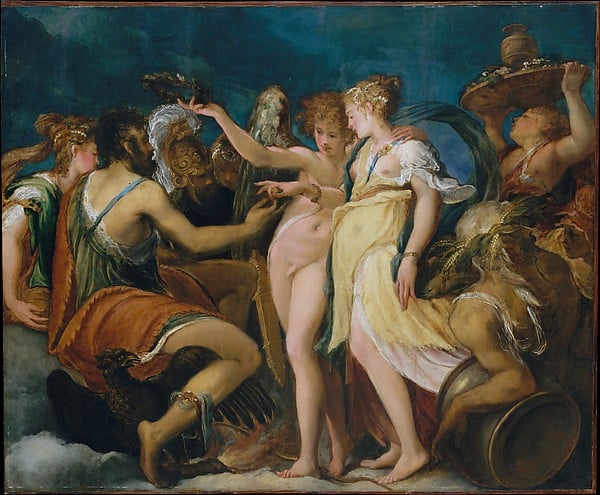Opinion
At Thomas Campbell’s Met, Numbers Came to Matter More than Art
THE DAILY PIC: Rare treasures like Andrea Schiavone's "Venus and Cupid" are why the Met exists—it doesn't matter if they don't draw the crowds.

THE DAILY PIC: Rare treasures like Andrea Schiavone's "Venus and Cupid" are why the Met exists—it doesn't matter if they don't draw the crowds.

Blake Gopnik

THE DAILY PIC (#1745): With the recent resignation of Thomas Campbell as director of the Metropolitan Museum of Art in New York, there has been lots of talk about his success or failure.
Whenever his successor is installed, here’s my suggestion for an impartial way to measure that new director’s achievement: The Met board should attach sensors to Andrea Schiavone’s Marriage of Cupid and Psyche, the Renaissance painting that is today’s Daily Pic, and to a few of the museum’s other similarly obscure but wonderful objects—a great Tibetan Buddha, a Greek vase, an African mask—and then track how many people stop in front of them, for how long, and how many of those same visitors come back to those objects more than once. (Facial recognition software should make it easy; the FBI should be able to help with the tech.)
If and only if Campbell’s successor substantially ups those numbers—if he or she gets visitors to spend more time and more repeat visits looking at the Met’s least-known and most surprising treasures—then praise will be in order. If not, it should be pink-slip time.
This is just the opposite of how Campbell’s tenure has been measured by people who ought to know better—including I think Campbell himself. The slew of critics and pundits who have weighed in on his departure have all raved about the increase in the sheer number of bodies that have poured into the Met during Campbell’s otherwise troubled tenure. Campbell may not have been much of a manager, they say, and he was probably bad at dollars and cents – but boy, could he grab the public’s attention. But when attendance numbers depend on shows that have almost no right to exist, is it a sign of success or failure?
As Philippe de Montebello, Campbell’s predecessor, once put it to me, if the Met just cared about head counts it could bring the Doors in for a concert—but how would that advance its mission or make its offerings different than what’s available elsewhere in the culture? (He gave that example more than 30 years after the Doors had stopped existing. De Montebello’s ignorance of pop culture was a source of his charm, and his success.)
And in fact a concert by the Doors would at least be holding up a great example of the art of rock and roll. Whereas the Met’s recent slew of crowd-pleasing shows have been almost completely bankrupt in anything like art-historical or scholarly terms. The low point was probably the exhibition of the Parisian bauble-maker known as JAR— jeweler to the .01 per cent—but the blockbuster shows at the Met’s Costume Institute have not been much better. It is simply a fact that Alexander McQueen will be a minor footnote in fashion history, however much he pleased the public in 2011. The Institute’s equally crowd-pleasing show called “Manus × Machina,” about the artisans of Parisian haute-couture, was so incoherent and weak-headed, despite the pile of notable objects it had to work with, that it would have earned a failing grade in any decent class on curating. It might have earned higher marks in a marketing course, where market-share is the only measure worth noting. (Every once in a while, the Costume Institute does do something that deserves a gold star, as with its great 2014 show about the American designer-cum-sculptor Charles James.)
Does the Met truly believe in the very special greatness of the objects it holds, or doesn’t it? If it does, then its central job is to make the general public care as much about them as the institution does, however hard that task may be—both for the Met itself and its audience. Even after 25 years as an art historian and critic, I still find looking at art endlessly challenging and exhausting—and worthwhile because of that, not despite it. If the Met halved its attendance and doubled the time each visitor spent with its objects—especially with objects that a visitor had no previous reason for knowing or liking—that would count as one of the greatest achievements in the museum’s history.
In his days as a lowly curator, Thomas Campbell made his mark doing something very much in that vein: He mounted shows that convinced surprisingly large numbers of people to care about the obscure but utterly fascinating topic of Renaissance and Baroque tapestries. It’s said that got colleagues calling him Tapestry Tom. Once he became director, he should have had that nickname printed up big on a button he wore every day. It might not have saved his job—museum boards are inevitably filled with plutocrats whose lifetime allegiance has been to numbers and money, not art—but it would have sent a signal that his Met had its priorities right.
For a full survey of past Daily Pics visit blakegopnik.com/archive.